Emerging Trends in Toxoplasmosis Seroepidemiology in Childbearing-Aged Women in Croatia, 2015–2024
Abstract
1. Introduction
2. Materials and Methods
2.1. Characteristics of Study Participants
2.2. Serological Testing
2.3. Statistical Analysis
3. Results
3.1. Toxoplasma gondii Seroprevalence Trends from 2015 to 2024
3.2. Toxoplasma gondii IgG Seroprevalence by Age
3.3. Toxoplasma gondii IgG Seroprevalence According to Geographic Region and Settlement
3.4. Risk Analysis for Toxoplasma gondii IgG Seropositivity
4. Discussion
5. Conclusions
Author Contributions
Funding
Institutional Review Board Statement
Informed Consent Statement
Data Availability Statement
Acknowledgments
Conflicts of Interest
Abbreviations
| EU/EEA | European Union/European Economic Area |
| IQR | Interquartile range |
| NUTS | Nomenclature of Territorial Units for Statistics |
| CI | Confidence intervals |
| ELFA | Enzyme-linked fluorescence assay |
| ELISA | Enzyme-linked immunosorbent assay |
References
- Daher, D.; Shaghlil, A.; Sobh, E.; Hamie, M.; Hassan, M.E.; Moumneh, M.B.; Itani, S.; El Hajj, R.; Tawk, L.; El Sabban, M.; et al. Comprehensive Overview of Toxoplasma gondii-Induced and Associated Diseases. Pathogens 2021, 10, 1351. [Google Scholar] [CrossRef]
- Robert-Gangneux, F.; Aubert, D.; Villena, I. Toxoplasmosis: A Widespread Zoonosis Diversely Affecting Humans and Animals. In Zoonoses: Infections Affecting Humans and Animals; Sing, A., Ed.; Springer: Cham, Switzerland, 2022. [Google Scholar] [CrossRef]
- Kota, A.S.; Shabbir, N. Congenital Toxoplasmosis. In StatPearls [Internet]; StatPearls Publishing: Treasure Island, FL, USA, 2025. Available online: https://www.ncbi.nlm.nih.gov/books/NBK545228/ (accessed on 13 June 2025).
- Petersen, E. Toxoplasmosis: Acute Systemic Disease. UpToDate. Available online: https://www.uptodate.com/contents/toxoplasmosis-acute-systemic-disease (accessed on 13 June 2025).
- Demar, M.; Hommel, D.; Djossou, F.; Peneau, C.; Boukhari, R.; Louvel, D.; Bourbigot, A.-M.; Nasser, V.; Ajzenberg, D.; Darde, M.-L.; et al. Acute Toxoplasmosis in Immunocompetent Patients Hospitalized in an Intensive Care Unit in French Guiana. Clin. Microbiol. Infect. 2012, 18, E221–E231. [Google Scholar] [CrossRef]
- Bossi, P.; Paris, L.; Caumes, E.; Katlama, C.; Danis, M.; Bricaire, F. Severe Acute Disseminated Toxoplasmosis Acquired by an Immunocompetent Patient in French Guiana. Scand. J. Infect. Dis. 2002, 34, 311–314. [Google Scholar] [CrossRef]
- Elsheikha, H.M.; Marra, C.M.; Zhu, X.Q. Epidemiology, Pathophysiology, Diagnosis, and Management of Cerebral Toxoplasmosis. Clin. Microbiol. Rev. 2020, 34, e00115-19. [Google Scholar] [CrossRef] [PubMed]
- Matta, S.K.; Rinkenberger, N.; Dunay, I.R.; Sibley, L.D. Toxoplasma gondii Infection and Its Implications within the Central Nervous System. Nat. Rev. Microbiol. 2021, 19, 467–480. [Google Scholar] [CrossRef] [PubMed]
- Layton, J.; Theiopoulou, D.C.; Rutenberg, D.; Elshereye, A.; Zhang, Y.; Sinnott, J.; Kim, K.; Montoya, J.G.; Contopoulos-Ioannidis, D.G. Clinical Spectrum, Radiological Findings, and Outcomes of Severe Toxoplasmosis in Immunocompetent Hosts: A Systematic Review. Pathogens 2023, 12, 543. [Google Scholar] [CrossRef]
- Bonetti, A.; Comelli, A.; Chiesa, A.; Spinoni, V.; Vola, A.; Prefumo, F.; Valcamonico, A.; Bonfanti, C.; Caligaris, S.; Tomasoni, L.R.; et al. Risk of Congenital Toxoplasmosis in Newborns from Mothers with Documented Infection: Experience from Two Referral Centres. Pathogens 2025, 14, 157. [Google Scholar] [CrossRef] [PubMed]
- Kieffer, F.; Wallon, M. Congenital Toxoplasmosis. Handb. Clin. Neurol. 2013, 112, 1099–1101. [Google Scholar] [CrossRef]
- Jaan, A.; Rajnik, M. TORCH Complex. In StatPearls [Internet]; StatPearls Publishing: Treasure Island, FL, USA, 2025. Available online: https://www.ncbi.nlm.nih.gov/books/NBK560528/ (accessed on 13 June 2025).
- Calero-Bernal, R.; Gennari, S.M.; Cano, S.; Salas-Fajardo, M.Y.; Ríos, A.; Álvarez-García, G.; Ortega-Mora, L.M. Anti-Toxoplasma gondii Antibodies in European Residents: A Systematic Review and Meta-Analysis of Studies Published between 2000 and 2020. Pathogens 2023, 12, 1430. [Google Scholar] [CrossRef]
- Findal, G.; Barlinn, R.; Sandven, I.; Stray-Pedersen, B.; Nordbø, S.A.; Samdal, H.H.; Vainio, K.; Dudman, S.G.; Jenum, P.A. Toxoplasma Prevalence among Pregnant Women in Norway: A Cross-Sectional Study. APMIS 2015, 123, 321–325. [Google Scholar] [CrossRef]
- Ferguson, W.; Mayne, P.D.; Lennon, B.; Butler, K.; Cafferkey, M. Susceptibility of Pregnant Women to Toxoplasma Infection—Potential Benefits for Newborn Screening. Ir. Med. J. 2008, 101, 220–221. [Google Scholar]
- Sagel, U.; Krämer, A.; Mikolajczyk, R.T. Incidence of Maternal Toxoplasma Infections in Pregnancy in Upper Austria, 2000–2007. BMC Infect. Dis. 2011, 11, 348. [Google Scholar] [CrossRef]
- Breugelmans, M.; Naessens, A.; Foulon, W. Prevention of Toxoplasmosis during Pregnancy—An Epidemiologic Survey over 22 Consecutive Years. J. Perinat. Med. 2004, 32, 211–214. [Google Scholar] [CrossRef]
- Veleminsky, M., Jr.; Veleminsky, M., Sr.; Fajfrlik, K.; Kolarova, L. Importance of Screening Serological Examination of Umbilical Blood and the Blood of the Mother for Timely Diagnosis of Congenital Toxoplasmosis and Toxocariasis. Neuro Endocrinol. Lett. 2010, 31, 310–312. [Google Scholar]
- Zemlianskii, O.A. O Seroépidemiologii Toksoplazmoza u Beremennykh Zhenshchin i Novorozhdennykh [Seroepidemiology of Toxoplasmosis in Pregnant Women and Neonatal Infants]. Med. Parazitol. 2004, 3, 40–42. [Google Scholar]
- Liassides, M.; Christodoulou, V.; Moschandreas, J.; Karagiannis, C.; Mitis, G.; Koliou, M.; Antoniou, M. Toxoplasmosis in Female High School Students, Pregnant Women and Ruminants in Cyprus. Trans. R. Soc. Trop. Med. Hyg. 2016, 110, 359–366. [Google Scholar] [CrossRef] [PubMed]
- Maggi, P.; Volpe, A.; Carito, V.; Schinaia, N.; Bino, S.; Basho, M.; Dentico, P. Surveillance of Toxoplasmosis in Pregnant Women in Albania. New Microbiol. 2009, 32, 89–92. [Google Scholar] [PubMed]
- Madireddy, S.; Mangat, R. Toxoplasmosis. [Updated 14 October 2024]. In StatPearls [Internet]; StatPearls Publishing: Treasure Island, FL, USA, 2025. Available online: https://www.ncbi.nlm.nih.gov/books/NBK563286/ (accessed on 4 August 2025).
- Dhakal, R.; Gajurel, K.; Pomares, C.; Talucod, J.; Press, C.J.; Montoya, J.G. Significance of a Positive Toxoplasma Immunoglobulin M Test Result in the United States. J. Clin. Microbiol. 2015, 53, 3601–3605. [Google Scholar] [CrossRef]
- Teimouri, A.; Mohtasebi, S.; Kazemirad, E.; Keshavarz, H. Role of Toxoplasma gondii IgG Avidity Testing in Discriminating between Acute and Chronic Toxoplasmosis in Pregnancy. J. Clin. Microbiol. 2020, 58, e00505-20. [Google Scholar] [CrossRef]
- Vilibic-Cavlek, T.; Ljubin-Sternak, S.; Ban, M.; Kolaric, B.; Sviben, M.; Mlinaric-Galinovic, G. Seroprevalence of TORCH infections in women of childbearing age in Croatia. J. Matern. Fetal Neonatal Med. 2011, 24, 280–283. [Google Scholar] [CrossRef]
- Vilibic-Cavlek, T.; Kolaric, B.; Belamaric, M.; Sviben, M.; Ferenc, T.; Navolan, D.; Bekic, V.; Milasincic, L.; Antolasic, L.; Vilibic, M.; et al. Screening for TORCH antibodies in Croatian childbearing-aged women, 2014–2023. Antibodies 2024, 13, 49. [Google Scholar] [CrossRef]
- Punda-Polić, V.; Tonkić, M.; Capkun, V. Prevalence of antibodies to Toxoplasma gondii in the female population of the County of Split Dalmatia, Croatia. Eur. J. Epidemiol. 2000, 16, 875–877. [Google Scholar] [CrossRef]
- Croatian Bureau of Statistics. The NUTS Classification in Croatia. Available online: https://dzs.gov.hr/highlighted-themes/prostorne-klasifikacije-i-subnacionalne-statistike-2-694/the-nuts-classification-in-croatia/699 (accessed on 8 July 2025).
- ECDC. Congenital Toxoplasmosis. Annual Epidemiological Report for 2021; European Centre for Disease Prevention and Control: Stockholm, Sweden, 2021; Available online: https://www.ecdc.europa.eu/sites/default/files/documents/congenital-toxoplasmosis-annual-epidemiological-report-2021.pdf (accessed on 15 June 2025).
- Berger, F.; Goulet, V.; Le Strat, Y.; Desenclos, J.C. Toxoplasmosis among pregnant women in France: Risk factors and change of prevalence between 1995 and 2003. Rev. Epidemiol. Sante Publique 2009, 57, 241–248. [Google Scholar] [CrossRef]
- Szénási, Z.; Horváth, K.; Sárkány, E.; Melles, M. Toxoplasmosis surveillance during pregnancy and quality assurance of methods in Hungary. Wien. Klin. Wochenschr. 2005, 117, 29–34. [Google Scholar] [CrossRef]
- Chen, K.T.; Eskild, A.; Bresnahan, M.; Stray-Pedersen, B.; Sher, A.; Jenum, P.A. Previous maternal infection with Toxoplasma gondii and the risk of fetal death. Am. J. Obstet. Gynecol. 2005, 193, 443–449. [Google Scholar] [CrossRef] [PubMed]
- Marković-Denić, L.; Stopić, M.; Bobić, B.; Nikolić, V.; Djilas, I.; Srzentić, S.J.; Štajner, T. Factors Associated with Toxoplasma gondii Seroprevalence in Pregnant Women: A Cross-Sectional Study in Belgrade, Serbia. Pathogens 2023, 12, 1240. [Google Scholar] [CrossRef] [PubMed]
- van den Berg, O.E.; Stanoeva, K.R.; Zonneveld, R.; Hoek-van Deursen, D.; van der Klis, F.R.; van de Kassteele, J.; Franz, E.; Opsteegh, M.; Friesema, I.H.M.; Kortbeek, L.M. Seroprevalence of Toxoplasma gondii and Associated Risk Factors for Infection in the Netherlands: Third Cross-Sectional National Study. Epidemiol. Infect. 2023, 151, e136. [Google Scholar] [CrossRef] [PubMed]
- Pribakovic, J.A.; Katanic, N.; Radevic, T.; Tasic, M.S.; Kostic, M.; Stolic, B.; Radulovic, A.; Minic, V.; Bojovic, K.; Katanic, R. Serological Status of Childbearing-Aged Women for Toxoplasma gondii and Cytomegalovirus in Northern Kosovo and Metohija. Rev. Soc. Bras. Med. Trop. 2019, 52, e20170313. [Google Scholar] [CrossRef]
- Roy, A.; Gaucher, L.; Dupont, D.; Menotti, J.; Atallah, A.; de la Fournière, B.; Massoud, M.; Lina, B.; Tirard-Collet, P.; Wallon, M. Epidemiological Changes in Toxoplasma Infection: A 7-Year Longitudinal Study in Pregnant Women in Lyon, France, 2017–2023. Parasite 2025, 32, 31. [Google Scholar] [CrossRef]
- Rainova, I.; Harizanov, R.; Videnova, M.; Tsvetkova, N.; Borisova, R.; Kaneva, E.; Todorova, Y. The Prevalence of Toxoplasmosis in Bulgaria for the Period 2014–2023, with a Focus on Pregnant Women. Pathogens 2025, 14, 270. [Google Scholar] [CrossRef]
- Fanigliulo, D.; Marchi, S.; Montomoli, E.; Trombetta, C.M. Toxoplasma gondii in Women of Childbearing Age and During Pregnancy: Seroprevalence Study in Central and Southern Italy from 2013 to 2017. Parasite 2020, 27, 2. [Google Scholar] [CrossRef] [PubMed]
- Robinson, E.; de Valk, H.; Villena, I.; Le Strat, Y.; Tourdjman, M. National perinatal survey demonstrates a decreasing seroprevalence of Toxoplasma gondii infection among pregnant women in France, 1995 to 2016: Impact for screening policy. Euro Surveill. 2021, 26, 1900710. [Google Scholar] [CrossRef] [PubMed]
- Meerburg, B.G.; Kijlstra, A. Changing Climate–Changing Pathogens: Toxoplasma gondii in North-Western Europe. Parasitol. Res. 2009, 105, 17–24. [Google Scholar] [CrossRef] [PubMed]
- Nowakowska, D.; Stray-Pedersen, B.; Spiewak, E.; Sobala, W.; Małafiej, E.; Wilczyński, J. Prevalence and Estimated Incidence of Toxoplasma Infection among Pregnant Women in Poland: A Decreasing Trend in the Younger Population. Clin. Microbiol. Infect. 2006, 12, 913–917. [Google Scholar] [CrossRef]
- Motoi, S.; Navolan, D.B.; Malita, D.; Ciohat, I.; Nemescu, D.; Manciuc, C.; Gorun, F.; Vilibic-Cavlek, T.; Boda, D.; Craina, M.; et al. A Decreasing Trend in Toxoplasma gondii Seroprevalence among Pregnant Women in Romania—Results of a Large-Scale Study. Exp. Ther. Med. 2020, 20, 3536–3540. [Google Scholar] [CrossRef]
- Pavia, G.; Licata, F.; Marascio, N.; Giancotti, A.; Tassone, M.T.; Costa, C.; Scarlata, G.G.M.; Prestagiacomo, L.E.; Gigliotti, S.; Trecarichi, E.M.; et al. Seroprevalence and Age-Related Susceptibility of TORCH Infections in Childbearing Age Women: A 5-Year Cross-Sectional Retrospective Study and a Literature Review. J. Infect. Public Health 2024, 17, 102537. [Google Scholar] [CrossRef]
- Ficik, J. Toxoplasmosis—Seroprevalence and Trend over 10 Years. Epidemiol. Mikrobiol. Imunol. 2025, 74, 11–19. [Google Scholar] [CrossRef]
- Nogareda, F.; Le Strat, Y.; Villena, I.; De Valk, H.; Goulet, V. Incidence and Prevalence of Toxoplasma gondii Infection in Women in France, 1980–2020: Model-Based Estimation. Epidemiol. Infect. 2014, 142, 1661–1670. [Google Scholar] [CrossRef]
- Stelzer, S.; Basso, W.; Benavides Silván, J.; Ortega-Mora, L.M.; Maksimov, P.; Gethmann, J.; Conraths, F.J.; Schares, G. Toxoplasma gondii Infection and Toxoplasmosis in Farm Animals: Risk Factors and Economic Impact. Food Waterborne Parasitol. 2019, 15, e00037. [Google Scholar] [CrossRef]
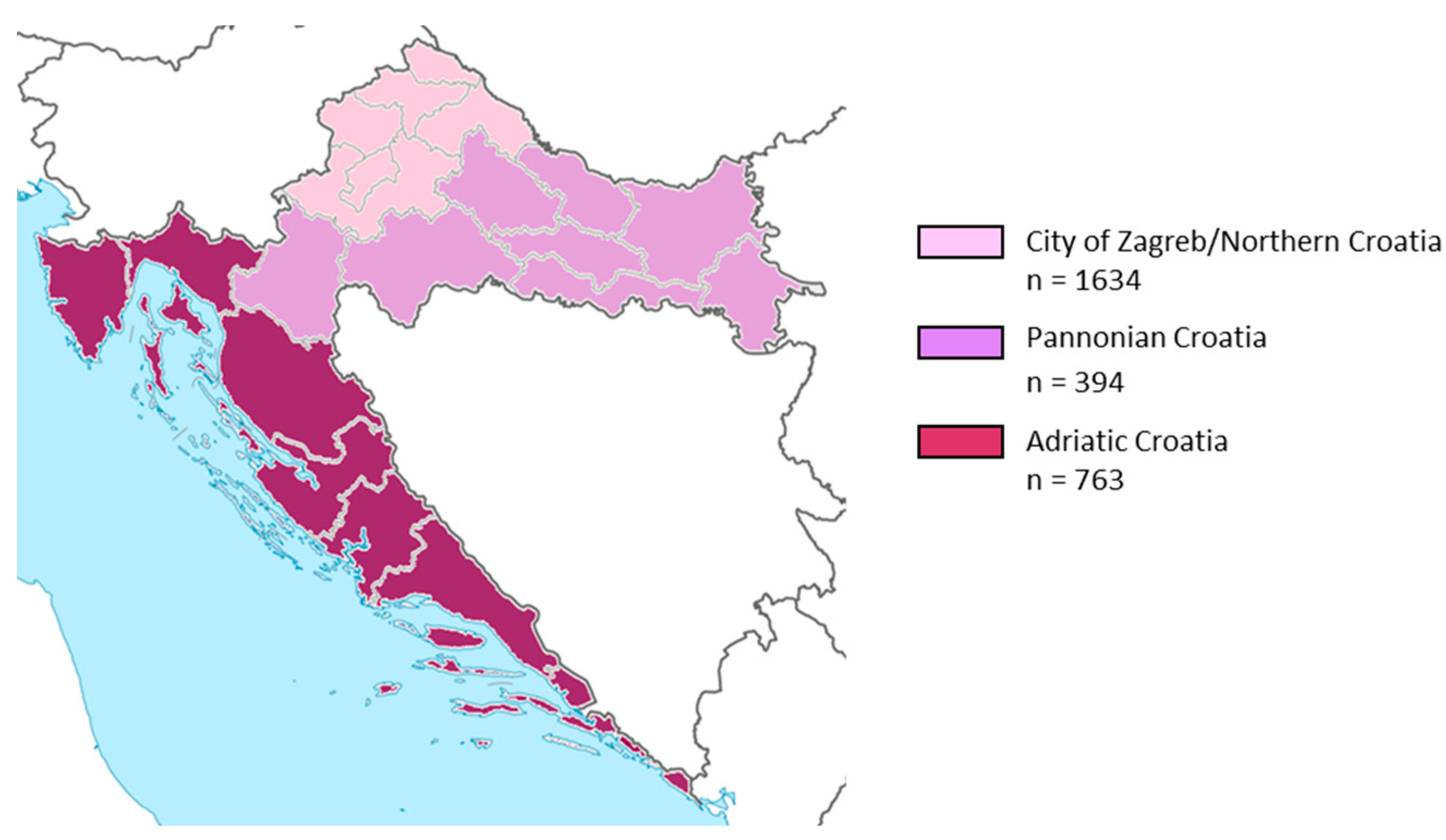
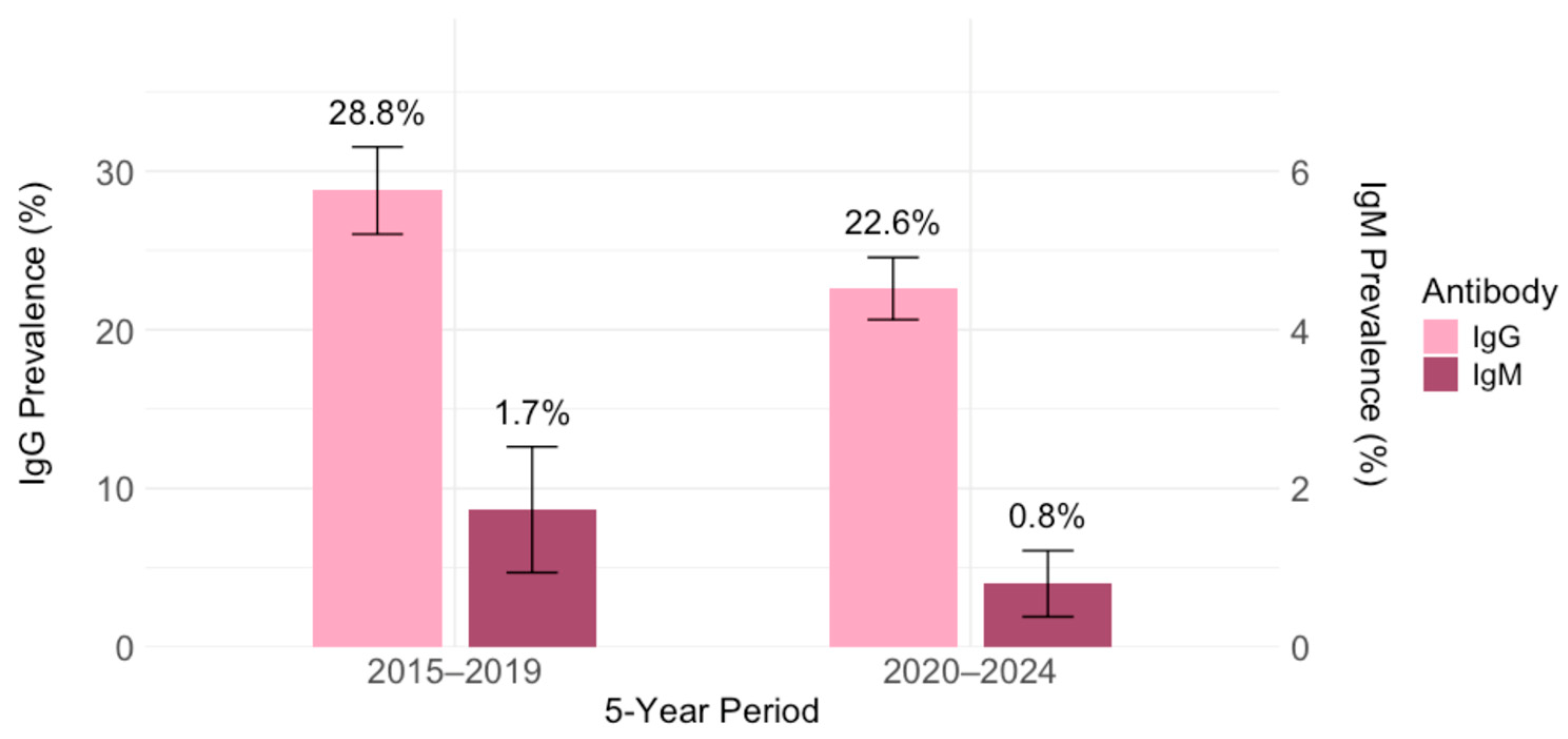
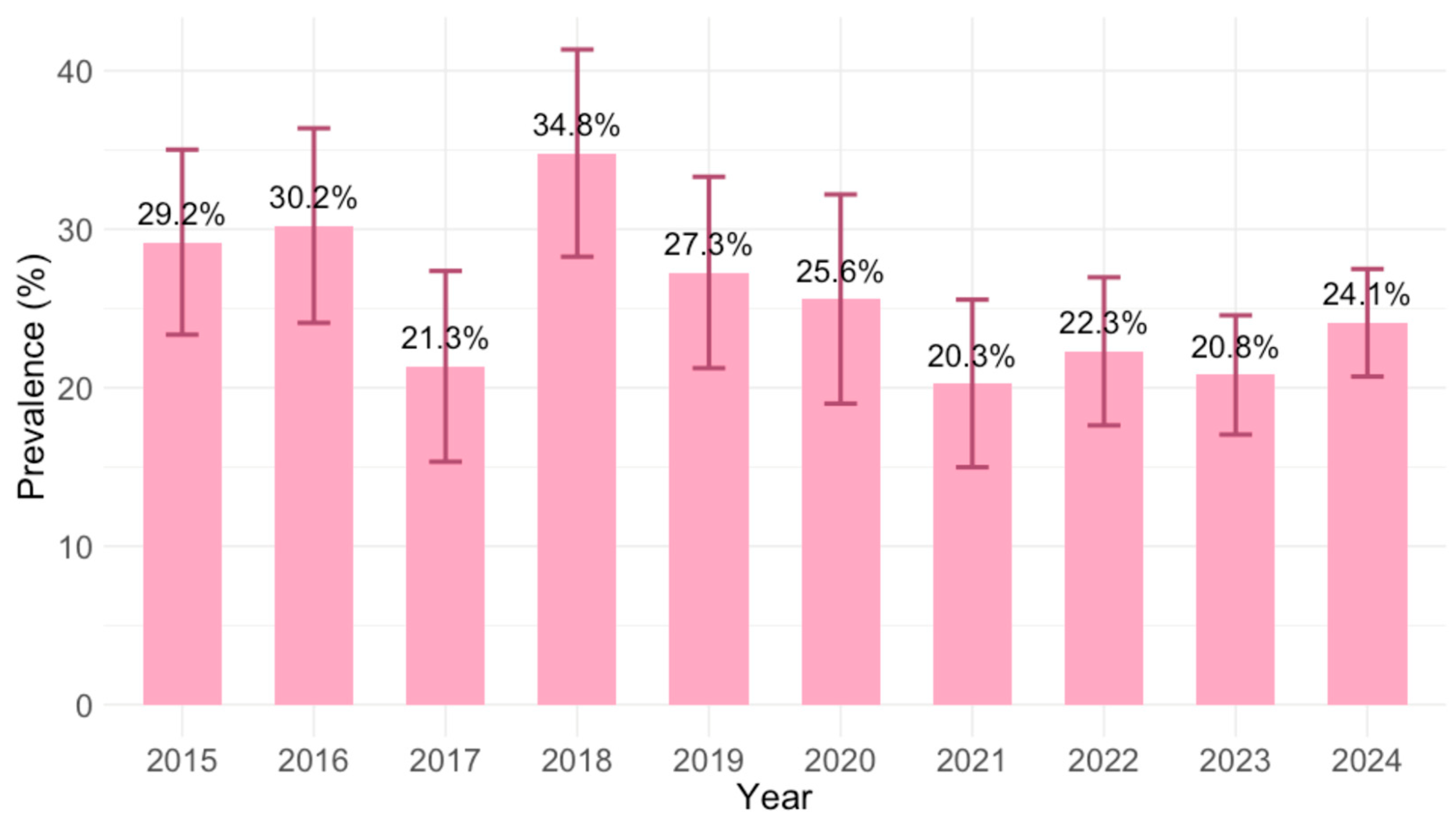
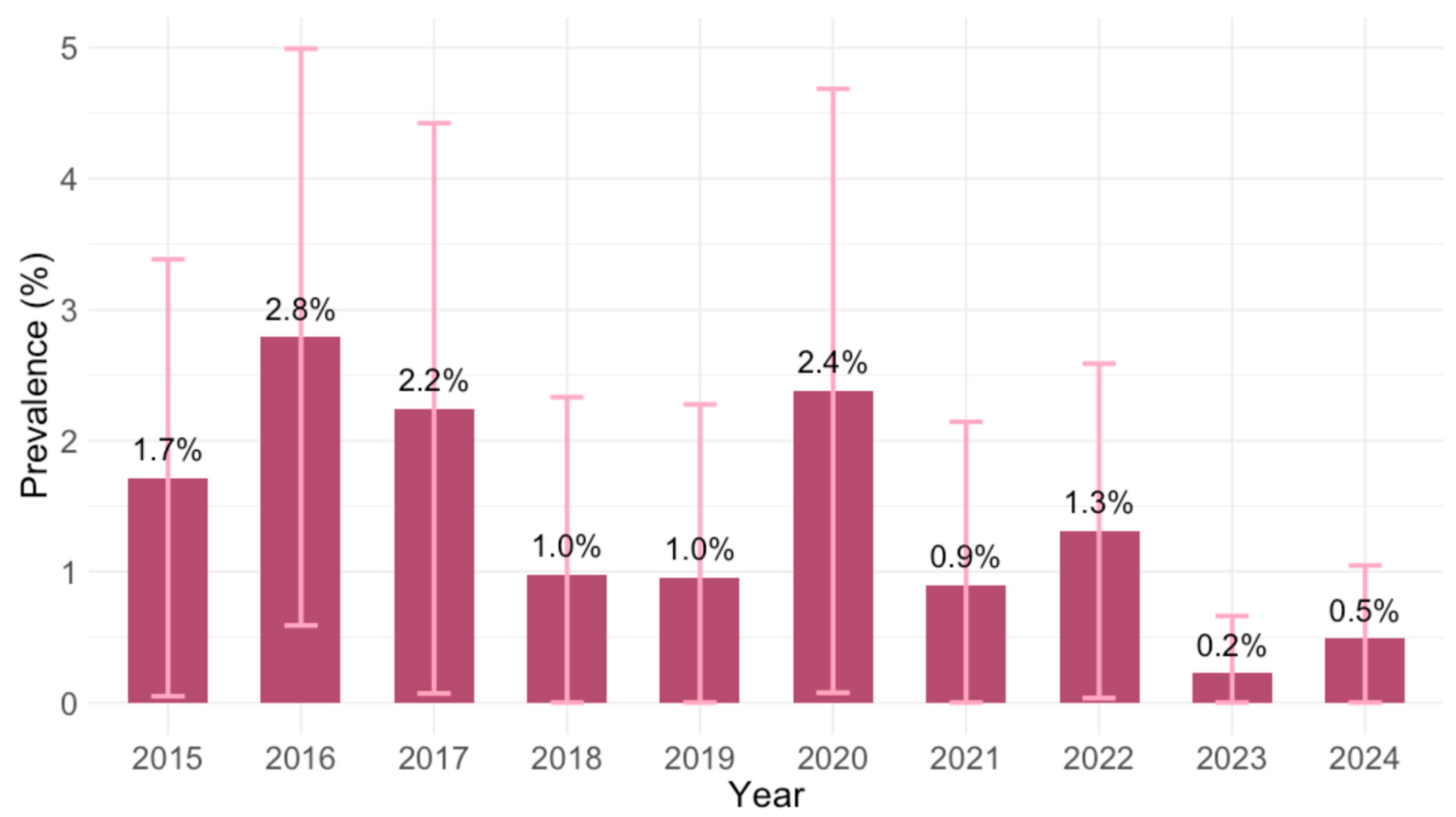
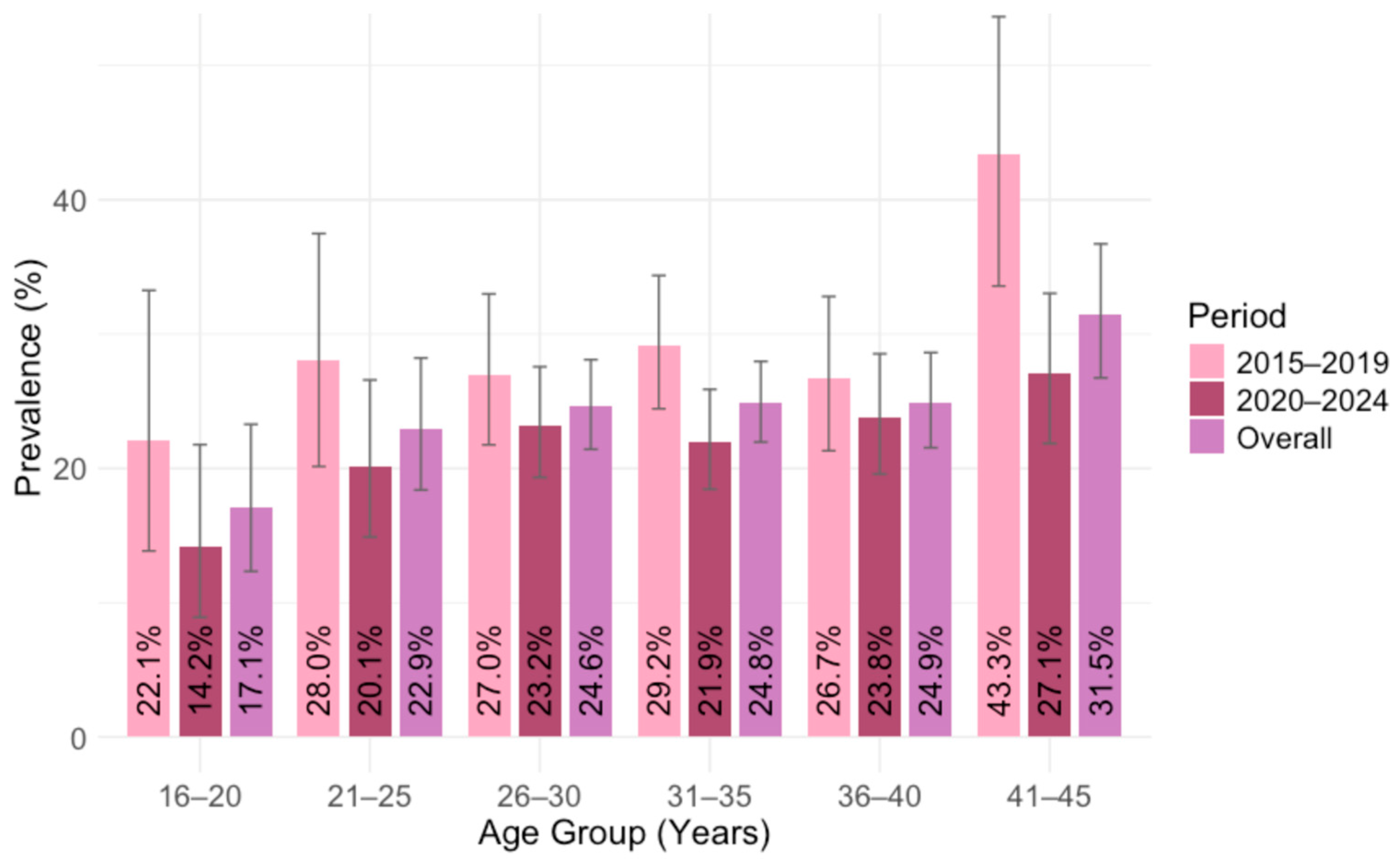

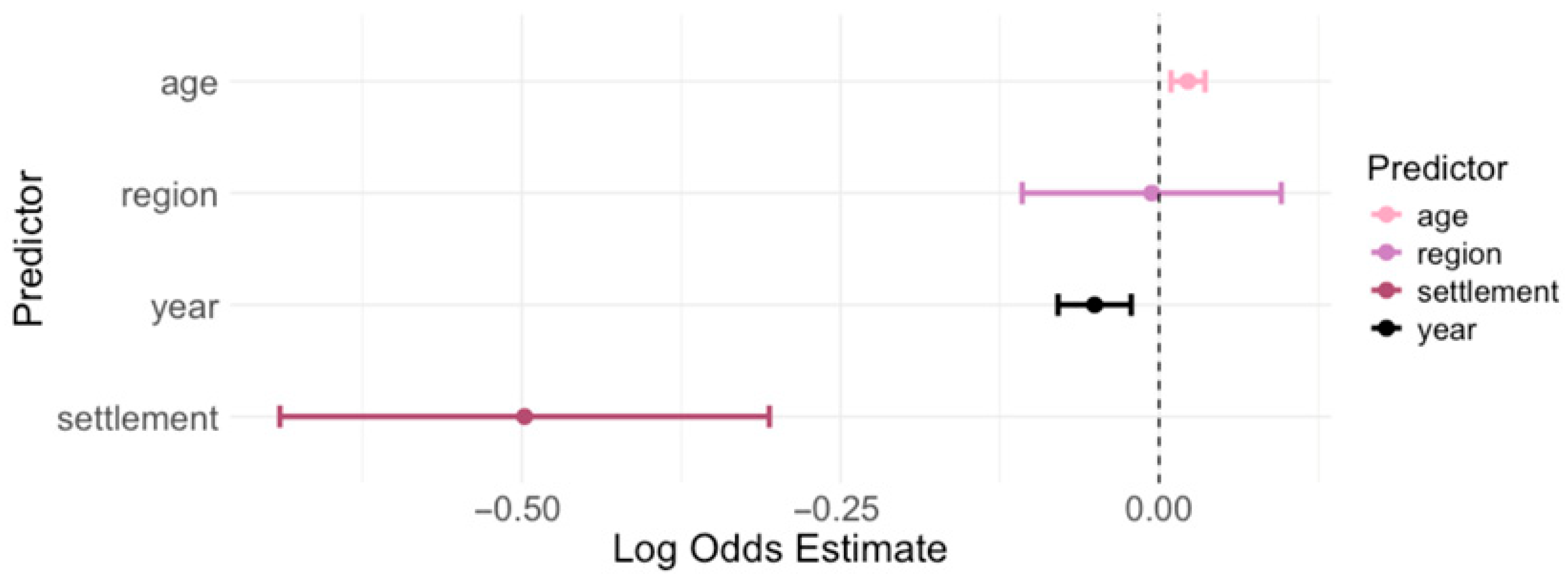
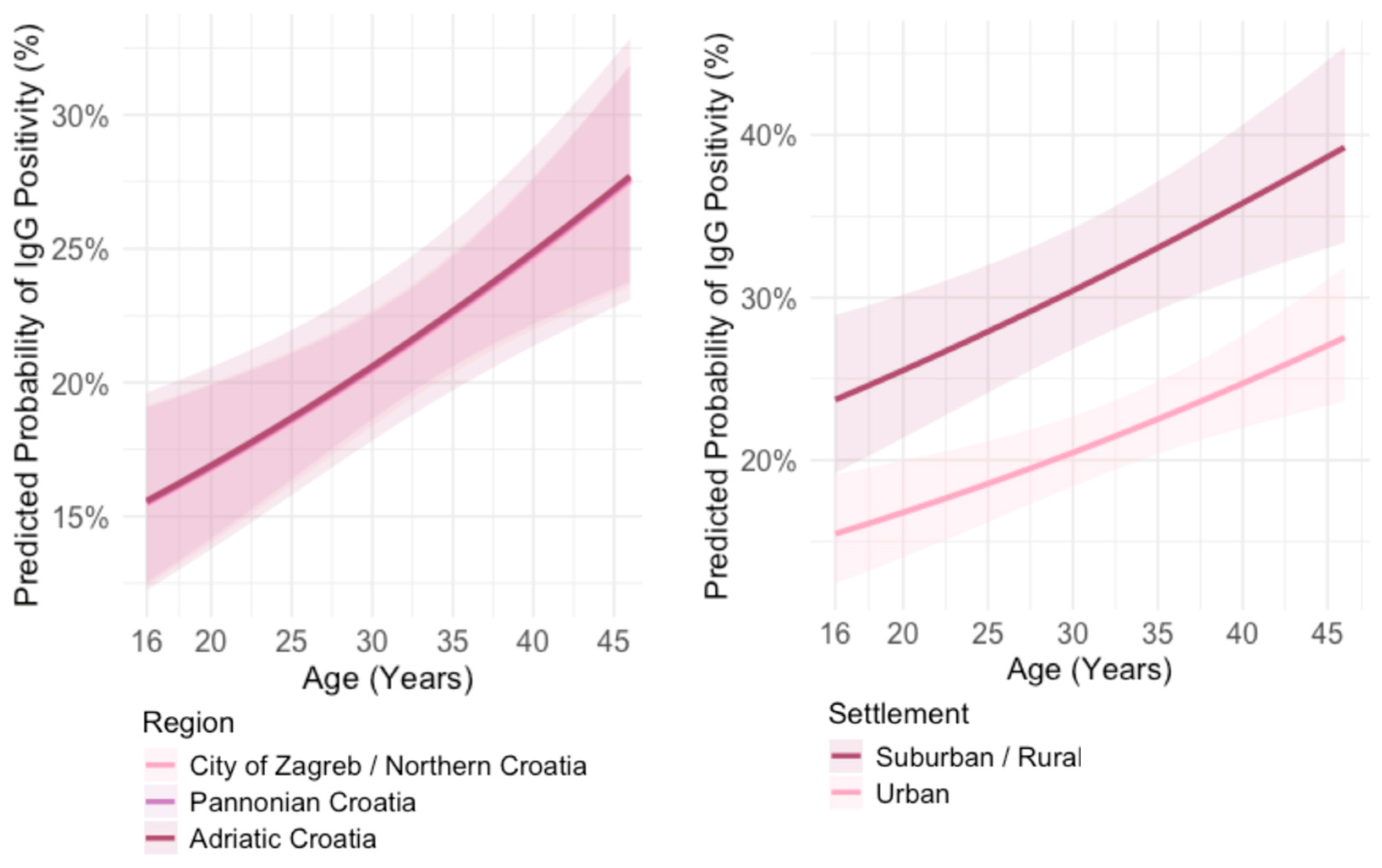
| Year | Toxoplasma gondii IgG Positive (95%CI) | ||||||
|---|---|---|---|---|---|---|---|
| 16–20 Yrs | 21–25 Yrs | 26–30 Yrs | 31–35 Yrs | 36–40 Yrs | 41–45 Yrs | p Value | |
| 2015 (n = 233) | 23.5% | 32.3% | 27.4% | 25.8% | 32.6% | 38.9% | 0.863 |
| (9.6–47.3) | (18.6–49.9) | (17.9–39.6) | (16.6–37.9) | (20.5–47.5) | (20.3–61.4) | ||
| 2016 (n = 215) | 33.3% | 15.8% | 36.0% | 20.9% | 34.7% | 50.0% | 0.098 |
| (13.8–60.9) | (5.5–37.6) | (24.1–49.9) | (12.9–32.1) | (22.9–48.7) | (29.0–71.0) | ||
| 2017 (n = 178) | 18.8% | 6.7% | 22.7% | 25.6% | 18.8% | 33.3% | 0.591 |
| (6.6–43.0) | (1.2–29.8) | (12.8–37.0) | (14.9–40.2) | (10.2–31.9) | (13.8–60.9) | ||
| 2018 (n = 204) | 15.4% | 47.6% | 23.1% | 42.3% | 21.2% | 50.0% | 0.026 |
| (4.3–42.2) | (28.3–67.6) | (12.6–38.3) | (32.0–53.4) | (10.7–37.8) | (29.9–70.1) | ||
| 2019 (n = 209) | 20.0% | 28.6% | 23.8% | 27.5% | 25.0% | 40.9% | 0.741 |
| (5.7–51.0) | (11.7–54.6) | (13.5–38.5) | (18.4–39.0) | (15.2–38.2) | (23.3–61.3) | ||
| 2020 (n = 168) | 7.1% | 23.1% | 29.3% | 24.2% | 33.3% | 27.3% | 0.584 |
| (1.3–31.5) | (8.2–50.3) | (17.6–44.5) | (15.2–36.2) | (18.6–52.2) | 89.7–56.6) | ||
| 2021 (n = 220) | 9.1% | 28.6% | 23.8% | 18.0% | 19.6% | 17.6% | 0.743 |
| (1.6–37.7) | (15.3–47.1) | (13.5–38.5) | (10.4–29.5) | (10.7–33.2) | (8.3–33.5) | ||
| 2022 (n = 305) | 24.1% | 17.9% | 28.1% | 18.8% | 15.1% | 28.6% | 0.408 |
| (12.2–42.1) | (9.0–32.7) | (18.6–40.1) | (11.1–30.0) | (7.9–27.1) | (18.4–41.5) | ||
| 2023 (n = 447) | 12.5% | 14.3% | 18.7% | 19.5% | 22.0% | 32.3% | 0.168 |
| (4.3–31.0) | (6.7–27.8) | (12.4–27.1) | (13.4–27.6) | (14.7–31.5) | (22.2–44.4) | ||
| 2024 (n = 610) | 11.4% | 21.1% | 22.4% | 25.4% | 28.1% | 25.7% | 0.418 |
| (4.5–26.0) | (12.5–33.3) | (16.5–29.8) | (19.5–32.5) | (21.1–36.5) | (17.1–36.7) | ||
| Parameter | Estimated Risk (Log Odds) | Standard Error | p Value |
|---|---|---|---|
| Year | −0.050569 | 0.014658 | <0.001 |
| Age | 0.022655 | 0.006810 | <0.001 |
| Region | −0.005753 | 0.051855 | 0.911 |
| Settlement | −0.497850 | 0.097975 | <0.001 |
Disclaimer/Publisher’s Note: The statements, opinions and data contained in all publications are solely those of the individual author(s) and contributor(s) and not of MDPI and/or the editor(s). MDPI and/or the editor(s) disclaim responsibility for any injury to people or property resulting from any ideas, methods, instructions or products referred to in the content. |
© 2025 by the authors. Licensee MDPI, Basel, Switzerland. This article is an open access article distributed under the terms and conditions of the Creative Commons Attribution (CC BY) license (https://creativecommons.org/licenses/by/4.0/).
Share and Cite
Sviben, M.; Barbić, K.; Bogdanić, M.; Reicher, E.; Glavaš, S.; Navolan, D.; Sanković, A.; Meštrović, T.; Mlinarić, I.; Vlădăreanu, S.; et al. Emerging Trends in Toxoplasmosis Seroepidemiology in Childbearing-Aged Women in Croatia, 2015–2024. Pathogens 2025, 14, 796. https://doi.org/10.3390/pathogens14080796
Sviben M, Barbić K, Bogdanić M, Reicher E, Glavaš S, Navolan D, Sanković A, Meštrović T, Mlinarić I, Vlădăreanu S, et al. Emerging Trends in Toxoplasmosis Seroepidemiology in Childbearing-Aged Women in Croatia, 2015–2024. Pathogens. 2025; 14(8):796. https://doi.org/10.3390/pathogens14080796
Chicago/Turabian StyleSviben, Mario, Klara Barbić, Maja Bogdanić, Ema Reicher, Sara Glavaš, Dan Navolan, Ana Sanković, Tomislav Meštrović, Ivan Mlinarić, Simona Vlădăreanu, and et al. 2025. "Emerging Trends in Toxoplasmosis Seroepidemiology in Childbearing-Aged Women in Croatia, 2015–2024" Pathogens 14, no. 8: 796. https://doi.org/10.3390/pathogens14080796
APA StyleSviben, M., Barbić, K., Bogdanić, M., Reicher, E., Glavaš, S., Navolan, D., Sanković, A., Meštrović, T., Mlinarić, I., Vlădăreanu, S., Vlădăreanu, R., & Vilibić-Čavlek, T. (2025). Emerging Trends in Toxoplasmosis Seroepidemiology in Childbearing-Aged Women in Croatia, 2015–2024. Pathogens, 14(8), 796. https://doi.org/10.3390/pathogens14080796









